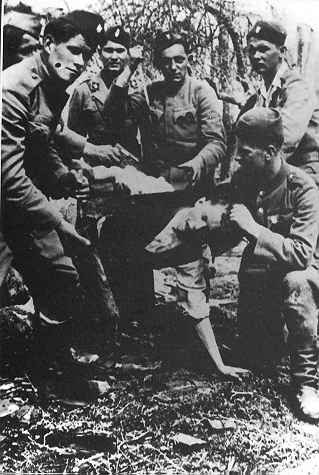|

Copyright © Sunday Telegraph 1995 May 7, 1995
Death camp capture revives Croat shame WHEN the Croats invaded the Serb enclave of western Slavonia last week, they recaptured the town of Jasenovac, the site of the largest extermination camp in the wartime Independent State of Croatia, whose Ustasha leader Ante Pavelic, was Hitler's staunchest ally. The timing - coming just a week before the VE Day celebrations - was a characteristically cackhanded reminder of events most Croatians would prefer the world to forget. Furthermore, it is only a few months after the last commandant of Jasenovac, Dinko Sakic, who had fled just before the camp was freed by the Partisans on May 2, 1945, returned to Croatia after a lengthy exile in Australia. Sakic has never been punished for his crimes nor made any apology for his work at Jasenovac, where at least 70,000 Serbs, Jews and Gypsies were slaughtered (some Serbs say it was nearer a million). On the contrary, to the fury of the Serbs and many Croat opponents of the present Zagreb regime, he said in a recent interview with the Zagreb journal Magazin: "I regret that we hadn't done all that is imputed to us, for had we done that then, today Croatia wouldn't have had problems, there wouldn't have been people to write lies . . .
The story of Jasenovac, and of Sakic's role there, has been recorded in the immense two volumes of published documents, Koncentracioni Logor Jasenovac 1941-1945. The editor, Antun Miletic, cannot be accused of pro-Serb bias, since he has also co-edited a volume of documents on Serb Chetnik atrocities during the Second World War, Genocid nad Muslimanima 1941-1945. In no small way, it explains at least in part the bitterness and passions that continue to fuel the bloody warfare still dogging the Balkans half a century after the Second World War drew to its close. When Pavelic was installed by Hitler in April 1941, as leader of the Independent State of Croatia, also comprising Bosnia-Hercegovina, he explained his policy to the two million Orthodox Serbs, as: "Convert a third, expel a third and kill a third." After four months of mass conversion, expulsion and massacre of the Serbs, Pavelic set up a chain of extermination camps, including one for women and children at Sisak. Jasenovac camp, at the confluence of the Sava and Una rivers, regularly held 3,000 to 6,000 inmates from September 1941 till May 2, 1945, when there were less than 100 left alive. Few prisoners lasted as long as three months, after which, in accordance with camp rules, they were executed by hanging, knifing, shooting or even burning alive.

When Hitler ordered his "Final Solution" of the Jewish problem in 1942, Jasenovac was the main extermination camp for this part of the Balkans. Most of the victims were Orthodox Serb peasants, rounded up in different parts of the Independent State of Croatia, and brought to Jasenovac in goods trains. Many Catholic Croats also perished at Jasenovac, including a number of priests who refused to conduct a Te Deum for Ante Pavelic. A guard who was caught by the Partisans, Ljubo Milos, has described how in April 1945, he and Sakic tried to remove the evidence of the killings at Jasenovac and the neighbouring camps. They dug up the mass graves and tried to cremate the remains. Newly-killed prisoners were usually thrown into the Sava with weights attached, or with their bellies cut open so that the corpses would not float to the surface. Since Dinko Sakic does not appear to have gone to work at Jasenovac until near the end of the war, the first reference I have found to him is for September 21, 1944, when he presided over the hanging of 20 prisoners. When one of them, Mile Boskovic exclaimed, "I demand to die in the Montenegrin fashion, from a bullet," Sakic obliged by shooting him with a revolver. A Serb former inmate at the neighbouring Nova Gradiska camp, described what happened after a Jew, Ivo Volner, was shot while attempting escape: "Immediately the Ustasha Second-Lieutenant Dinko Sakic ordered us all out on parade. "Then Volner's corpse was brought out on a stretcher and Sakic asked if any of us knew the dead prisoner, to which we replied that we knew him as Volner. "Then he asked who had contact with him, who slept in the same room, who was his friend. When nobody replied, he demanded to see the roll of prisoners, from which he called out the names of 100 Jews, and from this group he separated 25. When two Jews from the other group smiled . . . Sakic called them to him, ordered them to lie down then shot them with his pistol. These were the Jews Sado Perese and Avram Montiljo." In his recent interview with Magazin, Sakic explains why he did not return to Croatia earlier: "It was not out of concern for myself, or fear, but in order not to make problems for the President [Franjo Tudjman] and the government, for some people could have used my presence to burden the president with the accusation that the head of Jasenovac, a war criminal, walks the streets of Zagreb." This remark aroused mirth among those who recollect that Mr Tudjman's own recent book Wastelands, attempts to play down the atrocities of the Pavelic regime and even suggests that Jews helped to run Jasenovac. The Croatian satirical magazine Feral Tribune wrote: " Dinko Sakic is obviously not familiar with the political situation . . . He might have saved himself some travel expenses, for the President would have journeyed far to award him with some suitable medal." In the House of Commons on Wednesday, the Labour MP for Ilford South, Michael Gapes, asked why the war criminal Dinko Sakic was now at liberty in Croatia, and why Mr Tudjman's regime is to be represented at tomorrow's VE Day celebrations in London. |